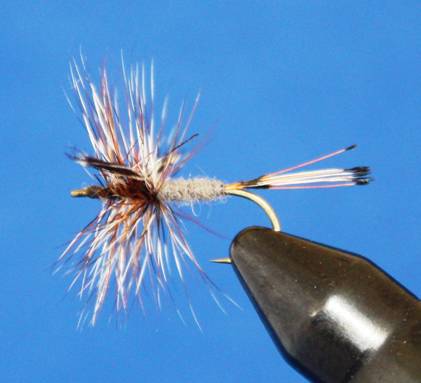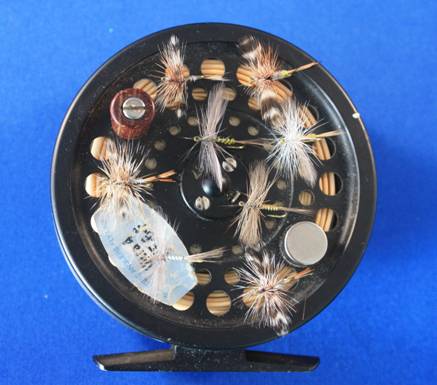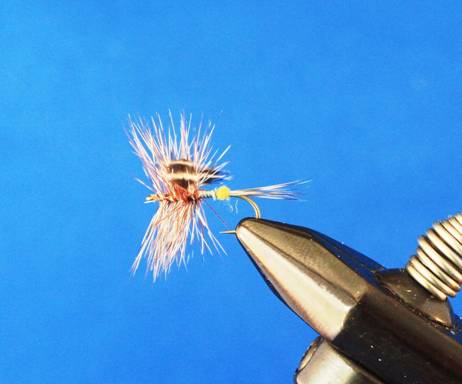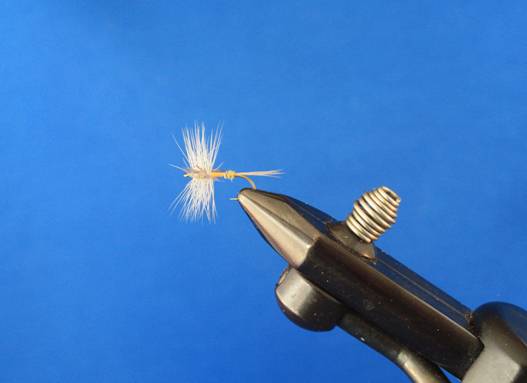EVENINGS ALONG THE STREAM (part 7)
| Sysadmin Note |
|---|
| Part Six can be found here |
June 28th, an event at home was the reason my clients had departed and this means that I have three days to fish on the spring creeks before my next trip begins. Back in part five I shared a story about wet spinners and their importance and in this selection I am going share a story about an old famous fly pattern and how spinners are important to the trout and the angler.
Once upon a time…..
Just kidding. I have always wanted to try that opening! The year was 2008, and the river is the Yellowstone. That year we enjoyed a good water year, meaning that there was plenty of snow in the mountains from the winter and the spring rains and even a late snow or two filled the Yellowstone to bank full, plus a little extra! There was no serious flooding, however the river received a good flushing and certain features were re-configured. This is not something bad. This is something good for a free-stone river like the Yellowstone. Due to the high, discolored water and swift current no one was on the river much before the third week of July.
This caused many of us who ply the river as fly fishing guides to travel to rivers like the Madison or Big Horn, or to spend many days on the spring creeks of Paradise Valley! Oh it's a tough life, but some of us are willing to make these sacrifices for our fly fishing adventures. Once the Yellowstone River became fishable in July it fished exceedingly well, and continued to fish well throughout August, September and into October. It's during these last two months that our tale begins.
September is a great month to fish the "Stone" as the weather is normally pleasant and the water levels have become more manageable. September sees the Yellowstone come alive with a number of major hatches and a scattering of lesser hatches which may be found in localized settings along the river.
That year the fishing on the Yellowstone was outstanding! Why, on some days even we older, vision-challenged anglers could take trout on a regular basis! Besides the small Baetis mayflies which were starting to appear there were a number of larger mayflies hatching during September: The Western Yellow Drake [Heptagenia elegantula], which is a size 14; the Gray Drake [Siphlonurus occidentalis], which is a size 12; the Giant Western Red Quill (commonly called Fall Drakes) [Ephemerlla Hecuba] (I believe the name has been changed) which is a size 10 and the Ghost Fly [Traverella albertana], which is a size 10, along with various other minor mayflies, late hatching caddis flies and various terrestrials. The Yellowstone can offer plenty of choices for the trout feeding on surface insects.
I had finished up a long stretch of guiding and was taking a few days to fish with a friend. During the early afternoon we noticed some very aggressive takes at the base of a deep riffle corner. My fishing partner, Paul, thought they were taking caddis emergers, based on the time of day and the water type, but the caddis emerger patterns failed to move the working trout.
I finally waded out below the rising trout and discovered there was a scattering of large mayfly spinners on the water. These big spinners were a mix of species and were still riding on the top of the surface film and occasionally flexing their wings. We joked about this flexing and hoped the trout were not keying on this! We really hadn't come properly prepared to fish larger, spent-winged imitations. We each had a nice, full box of drake spinner patterns sitting at home, of course.
As we poured through our boxes looking for something that might ride on top of the surface film, rather than in it, I came across a box of original Adams I had tied years ago. I showed them to Paul. His first comment was, "When do you think the last time was that someone used an original Adams on these fish?"
The next comment was, "Where did you come up with the box of Dinosaur Flies!" I hazard a guess that it had been awhile since anyone had used an original Adams on these fish. As for the Dinosaur remark, I said something like, "Hey, what do you mean dinosaur? This was one of Noah's favorite patterns."
Well, the size was right, the silhouette was correct and these would ride on top of the surface film rather than in it, so we tied them on and were both soon into lively rainbows that filled the air with their bright colors as they leaped repeatedly. After the day was over we discussed the pattern and decided to tie some modified patterns for the next day. Oh I can hear some of you saying "So what, an Adams worked! There is nothing special about that."
No, I said we used an original Adams. The Adams is, without a doubt, one of America's best known dry flies. But do you know about the Original Adams?
The famed Adams dry fly that we know today didn't start out as an up-winged dry fly; it began as a spent-winged imitation. The Adams was developed by Leonard Halladay of Mayfield, Michigan. It was first used in 1922 by Charles F. Adams of Lorain, Ohio and because of the unusual success Adams had with the fly on Michigan's Boardman River; Len Halladay named the Adams in his honor. However, the original pattern was tied spent. This information can be found in The Book of Fly Patterns, by Eric Leiser, published in 1987.
The original pattern can also be found in Fishing Flies and Fly Tying, by William F. Blades, published in 1951. I have a copy of the 1962 revised and enlarged edition of Blades' book. On page 116 is a listing for the Adams and on page 117 there is a black and white photo showing the original Spent Adams.

Adams (Leonard Halladay)
- Tails: Two strands of Golden Pheasant tippet or Grizzly Hackle Fibers (in Blades' book the photo clearly shows the Golden Pheasant tippet)
- Body: Gray Wool or Muskrat Fur, with a Grey Wool egg Sack
- Wings: Grizzly Hackle Tips, tied spent
- Hackle: Brown and Grizzly, tied together and wrapped
Who changed the Adams from the spent-winged imitation to the upright, winged dry fly that most anglers are familiar with? It most likely wasn't Halladay. I have heard several stories, but I believe that Art Winnie, also a Michigan fly tier, is the one credited for moving the wings upright and tying the tails with grizzly dry fly hackle. For a number of years many fly shops carried the standard, upright winged Adams and the Spent Adams as well. Even then the Spent Adams was also tailed with grizzly dry fly hackle fibers. Well, in today's world of new fly patterns and materials, the Spent Adams has fallen through the cracks of time. Just out of curiosity, I checked with many of the area fly shops--none carried the Spent Adams any longer. Many of those same fly shops explained that they seldom sell very many of the standard Adams anymore, with the Parachute Adams being much more popular.
We continued to fish the original Spent Adams with golden pheasant tippet tails throughout the rest of September and on into late October. After we had burned through my current supply we tied them in several different sizes, and tried them on a number of different area rivers. Besides the Yellowstone, we enjoyed good success with the original Spent Wing Adams on the Madison and Gallatin Rivers. We also used it on the rivers of Yellowstone National Park, on Slough Creek, the Lamar River and Soda Butte Creek. On each of the named rivers we enjoyed excellent success with the Spent Adams. It may be that an older pattern like the original Spent Adams has fallen out of favor with the anglers and fly shops, but I think that the in the end, the trout are the final judges and they still take it readily. Therefore, it must still be an effective pattern to have in the fly selection.
Why does the Spent Adams work so well on the rivers in Yellowstone Country? Because it an excellent imitation for the situation. The full hackled pattern sits on the surface of the water rather than in the surface film, thus presenting the proper imitation at the proper time and in a suitable manner that fools the trout. Often the anglers of today are so quick to change to new fly patterns that they forget why some of the old patterns worked.
But what happened to cause an effective pattern like the Spent Adams to fall by the wayside of angling. All fly tiers like to play with and modify fly patterns. Simply put, it is what we do. We are always looking for a pattern that is different, yet one that presents the proper, needed silhouette to make it successful. If we happen to discover a combination of materials that is effective, and if the successful pattern becomes popular, often it will take the place of something else in our boxes. This is a normal practice that has gone on as long as there have been fly tiers and trout!
In today's world of advertising and mass marketing it may happen a little quicker than it used to, but I don't believe in discarding old patterns when I add the new, as they all serve a function during certain angling situations.
Like all fly tiers, I have to play and modify patterns, so here is my modified version of the Spent Winged Adams. I call it the MM Spent Winged Adams (the MM stands for Modern and modified). This pattern has also led me to a couple other color variations that I have found most useful on the rivers of Yellowstone Country.
So don't be afraid of digging out some of those old patterns and giving them a try. You might find that the trout still like them.

I'll give you a hint--besides the standard up-winged dry flies, you might also try a few spent winged patterns and even some of the old wet fly patterns. Of course, this current generation of trout has seen very little of these flies and may think that they are new patterns. Thus explaining their effectiveness.

MM Spent Wing Adams
- Hook: Tiemco 101
- Sizes: 10-22
- Thread: Light Dun 12/0 or Gray 8/0
- Tails: Grizzly Hackle Dry Fly Fibers
- Egg Sack: Pale Yellow, dubbed natural fur or synthetic
- Abdomen: Gray Turkey Biot, wrapped
- Thorax: Muskrat Fur, dubbed
- Wings: Grizzly Hackle Tips, tied spent
- Hackle: Brown & Grizzly Dry Fly Hackles, mixed
Notes: Sometimes, I still tie a few up with Golden Pheasant Tippet for the tails: the trout seem to like the pattern regardless of the type of tail used. This full-hackled pattern is excellent on rough, broken water and for those of us with advancing years that are becoming, shall we say, visually challenged. The full-hackled Spent Adams is much easier to see on the water. When the spinner begins to float in the surface film, a quick change of patterns can be accomplished or you can simply trim the hackle off the bottom of the fully hackled Spent Adams and thus getting it to float more flush in the film. I would also like to point out that the Spent Adams is an excellent searching pattern.

MM Yellow Drake Spinner
- Hook: Tiemco 101
- Sizes: 12-16
- Thread: Light Dun 12/0
- Tails: Light Ginger Dry Fly Hackle Fibers
- Egg Sack: Yellow Fur or Synthetic, dubbed
- Abdomen: Sulfur Yellow Turkey Biot, wrapped
- Thorax: Dubbed, Pale Sulfur Yellow fur or synthetic
- Wings: Pale Light Dun Hackle Tips, tied spent
- Hackle: Light Dun Dry Fly Hackle
I have found by using the same basic pattern style and changing a few colors to match the naturals on the water that I'll be able to tie up a whole bunch of new spinners for next season. Go ahead-- tie a few up and give them a try, I think you will be surprised by the results!
Update December 2010: Since I originally penned this selection, I have continued to use the standard, full hackled spinner imitation. I can report that I have continued to enjoy great success with this pattern style. It has worked well in the rougher water types often encountered on rivers like the Yellowstone, Madison and Gallatin. I would also like to point out that the full hackled patterns have also been effective very late in the day on waters like the Henry's Fork and the Spring Creeks of Paradise Valley. This style of spinner is one of my top five searching fly patterns, when I see no sustained surface feeding.
| Sysadmin Note |
|---|
| Part Eight can be found here |
